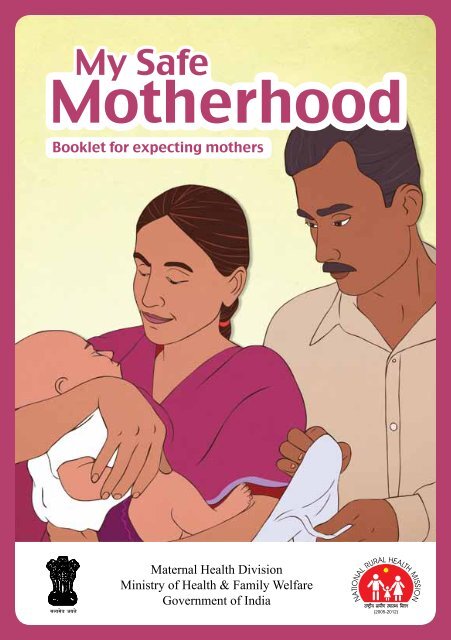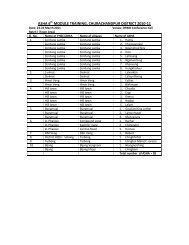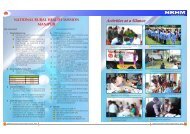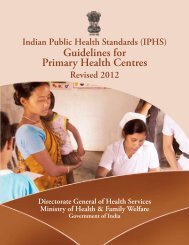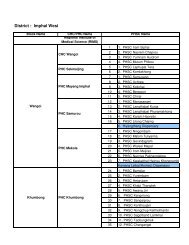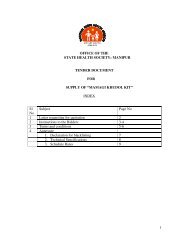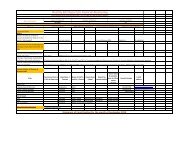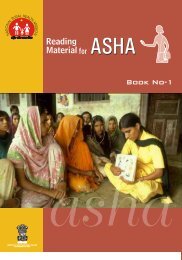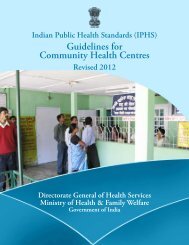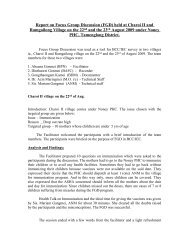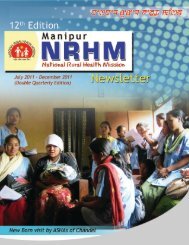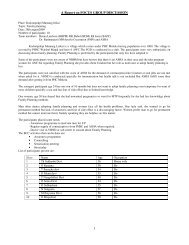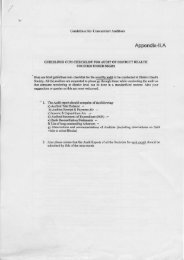Booklet for expecting mothers - NRHM Manipur
Booklet for expecting mothers - NRHM Manipur
Booklet for expecting mothers - NRHM Manipur
Create successful ePaper yourself
Turn your PDF publications into a flip-book with our unique Google optimized e-Paper software.
<strong>Booklet</strong> <strong>for</strong> <strong>expecting</strong> <strong>mothers</strong><br />
Maternal Health Division<br />
Ministry of Health & Family Welfare<br />
Government of India<br />
1
2<br />
Printed with technical support from UNICEF/WHO<br />
Illustrations by Mehul Mahicha Book Design by Lopez Design
My Name: Age:<br />
Husband’s Name: Phone No.:<br />
Address:<br />
No. of living children: a) Male b) Female<br />
LMP: EDD:<br />
Blood Group:<br />
Contact No. of:<br />
• ANM:<br />
• AWW:<br />
• ASHA:<br />
• Ambulance/Referral Transport:<br />
JSY Registration No.:<br />
BPL Beneficiary No.:<br />
Phone No. of PHC:<br />
Phone No. of FRU:<br />
Carry MCH card with you <strong>for</strong> all ANC/PNC/well baby visits<br />
and to the place you go <strong>for</strong> delivery<br />
3
REGISTRATION<br />
Register yourself at the nearest health facility as soon as pregnancy<br />
is detected.<br />
Four antenatal check ups are essential <strong>for</strong> a pregnant woman:<br />
First ANC Check up<br />
As soon as the period is missed or<br />
within first three months of missing<br />
the period.<br />
Second ANC Check up In 4th – 6th month of pregnancy.<br />
Third ANC Check up In 7th – 8th month of pregnancy.<br />
Fourth ANC Check up In 9th month of pregnancy.<br />
4<br />
Regular ANC visits protect you and your baby<br />
from complications and ensures healthy mother and child
ANTENATAL CHECK-UP<br />
Get your Hb, Blood pressure(BP), urine, weight and abdomen<br />
checked at every visit. Ensure that you receive IFA tablets and<br />
two doses of Inj. Tetanus Toxoid (TT). Always consult your MO<br />
if necessary or referred.<br />
Get urine tested <strong>for</strong> albumin and sugar. Get your weight checked. (Average<br />
weight gain during pregnancy is 9 -11 kg).<br />
Get your haemoglobin measured to<br />
assess anaemia.<br />
Haemoglobin estimation<br />
helps in early detection and<br />
treatment of anaemia<br />
Detection of albumin and<br />
sugar saves you and your<br />
baby from serious conditions<br />
5
ANTENATAL CHECK-UP<br />
Get your blood pressure checked to detect high BP which can be dangerous <strong>for</strong> you<br />
and your baby.<br />
Abdominal examination is important to assess foetal growth.<br />
6<br />
Abdominal Check-up during ANC helps in assessing<br />
foetal growth and its well- being
TETANUS TOxOId INjECTION<br />
Get two doses of T.T. injection at one month interval.<br />
Tetanus Toxoid Injection protects both mother and baby from<br />
Tetanus which is one of the life threatening conditions<br />
7
IRON FOLIC ACId (IFA) TABLETS<br />
During pregnancy 100 tablets of iron and folic acid will be given.<br />
One tablet of IFA is to be taken daily starting from the fourth month<br />
of pregnancy. If you are anaemic, you will be advised to take two IFA<br />
tablets daily, one tablet in the morning and one in the evening.<br />
8<br />
Taking one IFA tablet a day keeps anaemia away in <strong>mothers</strong><br />
and ensures delivery of a healthy baby
dIET dURING PREGNANCY<br />
• You need to eat one extra meal a day during pregnancy.<br />
• Take milk and dairy products like curd, buttermilk,<br />
paneer-these are rich in calcium, proteins and vitamins.<br />
• Eat fresh/seasonal fruits and vegetables as these provide<br />
vitamins and iron. Cereals, whole grains and pulses are<br />
good sources of proteins.<br />
• Green leafy vegetables are a rich source of iron and folic acid.<br />
• A handful (45 grams) of nuts and at least two cups of daal<br />
provide daily requirement of proteins in vegetarians.<br />
• For non-vegetarians, meat, egg, chicken or fish are good sources<br />
of proteins, vitamins and iron.<br />
A well balanced diet consisting of a variety of food helps<br />
in the growth of the baby and prevents anaemia<br />
9
RICH SOURCES OF IMPORTANT NUTRIENTS<br />
Iron Green leafy vegetables, whole<br />
grains, cereals, dry fruits, nuts,<br />
meat, jaggary.<br />
Calcium Milk, milk products, sesame<br />
seeds, almonds, soya milk,<br />
turnip, egg.<br />
Vitamins Orange and dark green<br />
vegetables, citrus fruits, apple,<br />
tomato, amla, vegetables, meat,<br />
fish, eggs, sunlight, milk and<br />
milk products, soya products.<br />
Proteins Paneer, milk and other milk<br />
products, combined grains,<br />
seeds, nuts, egg, meat, poultry,<br />
soya beans.<br />
Fats Butter, ghee, oils, nuts.<br />
10<br />
Prefer using variety of local seasonal foods, vegetables and fruits<br />
being grown in and around your area
CLEANLINESS<br />
Wash your hands with soap and water<br />
be<strong>for</strong>e every meal and after attending<br />
toilet of self and baby.<br />
Clip your nails regularly.<br />
Personal hygiene prevents acquiring infection<br />
and also from transmitting to the baby<br />
11
REST dURING PREGNANCY<br />
• Have 8 hours of sleep at night and at least 2 hours rest during the day.<br />
• Lie on your left side as it increases the blood supply to the foetus.<br />
• Avoid hard work such as lifting heavy weight.<br />
• Do not overexert yourself and delegate few tasks to others.<br />
12<br />
Adequate rest gives you physical and mental relaxation<br />
which is good both <strong>for</strong> you and the baby
FAMILY SUPPORT<br />
• Family behaviour and<br />
attitude should be<br />
pleasant and<br />
encouraging.<br />
• Family should ensure<br />
provision of healthy<br />
diet and timely visits<br />
to health facility.<br />
• Avoid delay in contacting<br />
medical facility when<br />
labour starts or in case<br />
of a complication.<br />
• Adequate finance and<br />
transport should be<br />
arranged be<strong>for</strong>ehand.<br />
• A blood donor should<br />
be identified <strong>for</strong> any<br />
un<strong>for</strong>eseen emergencies.<br />
Care and support by husband<br />
and mother-in-law gives<br />
emotional support and confidence<br />
in child bearing<br />
13
dANGER SIGNALS dURING PREGNANCY<br />
Severe pain in abdomen.<br />
Bleeding per vaginum.<br />
Convulsions.<br />
14<br />
Generalised weakness, easy fatigability<br />
and breathlessness.<br />
Excessive swelling in legs.<br />
Fever.<br />
If any complications occur- seek help immediately<br />
to preserve your health and life
dANGER SIGNALS dURING PREGNANCY & LABOR<br />
Immediately contact ANM/MO in case of following:<br />
Contact P H C<br />
Burning micturition.<br />
High grade fever or<br />
any medical illness.<br />
Vaginal bleeding in early<br />
pregnancy.<br />
Excessive nausea and vomiting.<br />
Leaking per vaginum be<strong>for</strong>e<br />
onset of labour.<br />
High blood pressure detected<br />
in ANC.<br />
Fainting and/or pain in<br />
abdomen.<br />
Contact F R U<br />
Vaginal bleeding in advanced<br />
pregnancy.<br />
Decreased or no foetal<br />
movements.<br />
Swelling all over body,<br />
palpitations, shortness<br />
of breath.<br />
Swelling all over body<br />
and/or blurring of vision.<br />
High blood pressure<br />
detected in ANC.<br />
Fits.<br />
Labour pains or leaking be<strong>for</strong>e<br />
9 month of pregnancy.<br />
Leaking <strong>for</strong> more than<br />
12 hours without labour pains.<br />
Foul smelling leaking with or<br />
without fever.<br />
Labour pains more than<br />
12 hours.<br />
Continuous abdominal pain.<br />
Seek timely help from facility <strong>for</strong> proper management of<br />
complications - it saves your life as well as the baby’s<br />
15
POSTPARTUM CARE<br />
• It is important to stay in health facility where you deliver <strong>for</strong> a minimum<br />
of 48 hours as most complications in mother and baby occur then.<br />
• You and your baby should be seen by a health worker on the day<br />
of delivery, and on 3rd day, 7th day and 6 weeks after delivery.<br />
• You should get vaccination <strong>for</strong> 0 dose Polio, Hepatitis B (if recommended<br />
under routine immunisation) and BCG on the first day.<br />
• You will also receive Counselling on cord care, Keeping the baby<br />
warm, Respiratory infections, loose motion, Nutrition and family<br />
planning during your stay.<br />
• Take extra calories & fluids to fulfill requirements of breast feeding.<br />
• Take adequate rest.<br />
• Take immediate medical help if any complication occurs in yourself<br />
or your baby.<br />
PROBLEMS AFTER dELIVERY<br />
Contact P H C<br />
Tear in perineum<br />
Inability to pass urine<br />
Burning in urination<br />
Difficulty in breast feeding<br />
Pain lower abdomen<br />
16<br />
Contact F R U<br />
Excessive vaginal bleeding<br />
Inability to control defecation/urine<br />
Foul smelling vaginal discharge<br />
Difficulty in breathing<br />
Blurred vision and fits<br />
Fever<br />
Fainting<br />
Post delivery care ensures good health<br />
and wellness <strong>for</strong> you and your baby
NEWBORN CARE<br />
Following conditions in a baby needs contact with M. O. or ANM<br />
1. Difficulty in breathing<br />
2. Inability to suck<br />
3. Inablity to pass urine and stools<br />
4. Umbilical stump is red or has pus<br />
5. More than 10 pustules over<br />
body or one large boil<br />
6. Jaundice<br />
• Baby should be:<br />
- Dried and wrapped immediately after birth.<br />
- Properly covered according to weather<br />
conditions and to be kept warm.<br />
Head and feet should be kept covered.<br />
- Given bath only after 48 hours.<br />
- Passing stools at least once in first 24 hours<br />
and urine at least once in first 48 hours.<br />
• Burping should be done after every feed.<br />
• Cord stump should be kept clean and dry.<br />
Apply nothing on the cord stump.<br />
Choose to deliver in an institution - it provides timely help<br />
<strong>for</strong> mother and baby if complications occur<br />
dANGER SIGNALS IN NEW BORN<br />
7. Fever<br />
8. Diarrhoea<br />
9. Dull and lethargic baby<br />
10. Seizure<br />
11. Eyes are red or infected<br />
12. Any birth defects are seen<br />
Seek advice of your MO/ANM immediately if any complication<br />
is seen - timely treatment saves life of baby<br />
17
BREASTFEEdING<br />
• You should start breastfeeding<br />
your new born at the earliest,<br />
preferably within one hour<br />
of delivery to develop proper<br />
sucking.<br />
• Breast milk of first day<br />
(colostrum) is very useful<br />
<strong>for</strong> the newborn because<br />
it is nutritious and rich in<br />
protective antibodies against<br />
common infections like<br />
measles.<br />
• Exclusive breastfeeding should<br />
be done <strong>for</strong> six months and no<br />
prelacteal feeds (gripe water,<br />
honey) should be given to the<br />
baby during this time.<br />
• Breastfeeding should be given<br />
on demand.<br />
• Exclusive breastfeeding<br />
decreases the chances<br />
of diarrhoea and upper<br />
respiratory tract infections<br />
in the newborn; it decreases<br />
chances of pregnancy during<br />
that period.<br />
18<br />
Mother’s milk is best <strong>for</strong> health and<br />
growth of your baby<br />
Give only breast feeds to your baby <strong>for</strong> six months<br />
and protect baby from illnesses like diarrhoea and others
COMPLEMENTARY FEEdING<br />
• Any food given to the baby in addition to breast milk is called<br />
complementary foods.<br />
• After the age of 6 months, breast milk is not enough <strong>for</strong> mental and<br />
physical growth of the baby so complementary feeding is essential.<br />
Type of Food Age (month) Frequency of serving<br />
Mashed roti/rice/bread/biscuit mixed<br />
in sweetened undiluted milk.<br />
OR<br />
Mashed roti/rice/bread mixed in thick dal<br />
with added ghee/oil or khichri with added<br />
oil/ghee. Add cooked vegetables (such as<br />
potatoes, carrots, green leafy vegetables,<br />
yellow pumpkins, etc) also in the servings.<br />
OR<br />
Sevian/dalia/halwa/kheer prepared in milk or<br />
any cereal porridge cooked in milk.<br />
OR<br />
Mashed boiled/fried potatoes or give one<br />
seasonal fruit (banana/ cheeko/ mango)<br />
or meat, fish and egg.<br />
Rice, dal, chapatti (cereals or millets),<br />
yogurt, seasonal fruits (such as banana,<br />
guava,mango etc.), vegetables (such as<br />
potatoes, carrots,beans.<br />
Add ladoo, biscuits, bread and other<br />
nutritious food.<br />
6-12 months Give1 katori serving<br />
3 times a day, if breastfed<br />
and 5 times a day, if the<br />
child is not breastfed.<br />
12-24 months Give one & half katori<br />
serving 5 times a day.<br />
The variety in the diet<br />
should be increased by<br />
including the family foods<br />
in the diet of the child.<br />
More than 24<br />
months<br />
3 times every day.<br />
Two times a day in between<br />
the meals.<br />
It is important <strong>for</strong> you to understand that:<br />
• Girls and boys need equal amount of food.<br />
• Wash your own and child’s hands with soap and water every time<br />
be<strong>for</strong>e feeding.<br />
• Sit with the child at meal times.<br />
• Give food in a separate bowl to make sure she/he gets enough food<br />
and eats the correct amount.<br />
Timely introduction of a variety of energy rich complementary foods in<br />
adequate amounts in addition to breastfeeding keeps the baby healthy<br />
19
IMMUNISATION SCHEdULE FOR BABY<br />
Take your baby to the nearest health centre <strong>for</strong> immunisation.<br />
At birth BCG, OPV - 0 dose, Hepatitis B - 0 dose*<br />
6 weeks BCG (if not given at birth)<br />
DPT - 1 st dose<br />
OPV - 1 st dose<br />
Hepatitis B - 1 st dose*<br />
10 weeks DPT - 2 nd dose<br />
OPV - 2 nd dose<br />
Hepatitis - 2 nd dose*<br />
14 weeks DPT - 3 rd dose<br />
OPV - 3 rd dose<br />
Hepatitis - 3 rd dose*<br />
9 months Measles, Vit-A - 1 st dose<br />
16-24 months DPT booster, MR<br />
OPV boosters Vit-A - 2 nd dose<br />
2 to 5 years Vit-A - 3 rd to 9 th doses at the interval of 6 months.<br />
(total of 7 doses)<br />
5 years DPT booster<br />
10 years T.T. booster<br />
16 years T.T. booster<br />
* If recommended under Routine Immunisation.<br />
20<br />
Follow immunisation schedules <strong>for</strong> protection of your babies<br />
from life threatening and crippling diseases
FAMILY PLANNING AdVICE (SPACING METHOdS)<br />
A gap of two to five years is recommended between pregnancies <strong>for</strong><br />
restoration of your health and proper care of your baby. A number of<br />
contraceptive methods are available <strong>for</strong> spacing pregnancies.<br />
Lactational amenorrhea method (LAM)<br />
protects from pregnancy <strong>for</strong> six months<br />
if exclusive breast feeding Is done.<br />
D M P A<br />
One Injection of DMPA is given every<br />
three months It can be used during<br />
breastfeeding.<br />
Condom<br />
Spacing method <strong>for</strong> males.<br />
It protects from pregnancy and<br />
sexually transmitted infections.<br />
Intra Uterine Contraceptive Device (IUCD)<br />
It is one time method and is effective<br />
upto 10 years.<br />
Oral Contraceptive Pills (OCPs)<br />
OCPs can be started 6 months after<br />
delivery; one pill is to be taken daily.<br />
Start immediately if not breastfeeding.<br />
3 years spacing between<br />
child bearing ensures<br />
healthy mother and baby<br />
21
FAMILY PLANNING AdVICE<br />
(PERMANENT METHOdS)<br />
If your family is complete, you can opt <strong>for</strong> a permanent method of<br />
contraception i.e. tubectomy or vasectomy.<br />
Tubectomy (female sterilisation)<br />
Tubectomy can be done immediately<br />
after delivery or any time after six weeks<br />
after delivery or between deliveries. Can<br />
be minilap or laparoscopic method.<br />
22<br />
Small family - Happy family<br />
Vasectomy (male sterilisation)<br />
Vasectomy can be done by a very<br />
small incision. Vasectomy does not<br />
cause any weakness, and does not<br />
need long rest.<br />
Leaves more to eat, educate your children,<br />
save <strong>for</strong> home, health and old age
NOTES<br />
23


